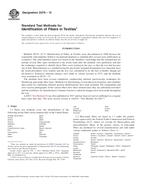Potřebujeme váš souhlas k využití jednotlivých dat, aby se vám mimo jiné mohly ukazovat informace týkající se vašich zájmů. Souhlas udělíte kliknutím na tlačítko „OK“.
ASTM D276-12
Standard Test Methods for Identification of Fibers in Textiles (Withdrawn 2021)
Automaticky přeložený název:
Standardní zkušební metody pro identifikaci vláken v textilním
NORMA vydána dne 1.2.2012
Informace o normě:
Označení normy: ASTM D276-12
Poznámka: NEPLATNÁ
Datum vydání normy: 1.2.2012
Kód zboží: NS-21409
Počet stran: 14
Přibližná hmotnost: 42 g (0.09 liber)
Země: Americká technická norma
Kategorie: Technické normy ASTM
Kategorie - podobné normy:
Anotace textu normy ASTM D276-12 :
Keywords:
0 Animal fibers, Animal hair, Archimedes method, Bast and leaf fibers/products, Birefringence, Cotton fabrics/fibers, Fiber analysis--textiles, Fiber density, Fisher-Johns apparatus, Identification, Infrared (IR) analysis, Infrared spectroscopy, Man-made textile fibers, Melting point, Microscopic examination--textiles, Refractive index, Silk, Solubility, Textile fibers, Textile fibers--bast and leaf, Wool and wool top, ICS Number Code 59.060.01 (Textile fibres in general)
Doplňující informace
| Significance and Use | ||||||||||||||||||||||||||||||||||||||||||||||||||||||||||||||||||||||||||||||||||||||||||||||||||||||||||||||||||
|
These test methods are a generally reliable means of identifying the generic types of fibers present in a sample of textile material of unknown composition. The methods are generally not useful for distinguishing fibers of the same generic class from different manufacturers or for distinguishing different fiber types of the same generic class from one producer. Many fibers are chemically modified by their producers in various ways so as to alter their properties. It is possible for such modifications to interfere seriously with the analyses used in these test methods. Considerable experience and diligence of the analyst may be necessary to resolve satisfactorily these difficulties. Dyes, lubricants, and delustrants are not present normally in amounts large enough to interfere with the analyses. These test methods are not recommended for acceptance testing of commercial shipments because of the qualitative nature of the results and because of the limitations previously noted. Note 2—For statements on precision and bias of the standard quantitative test methods for determining physical properties for confirmation of fiber identification refer to the cited test method. The precision and bias of the nonstandard quantitative test methods described are strongly influenced by the skill of the operator. The limited use of the test methods for qualitative identification cannot justify the effort that would be necessary to determine the precision and bias of the techniques. 5.5 Qualitative and quantitative fiber identification is actively pursued by Committee RA24 (Fiber Identification) of AATCC and presented in AATCC Test Method 20 and Test Method 20A. Since precision and bias development is also part of the AATCC test methods, both AATCC and ASTM D13 have agreed that new development will take place in RA24. However, because there is valuable information still present in the ASTM standards, Test Methods D276 and D629 will be maintained as active standards by ASTM. |
||||||||||||||||||||||||||||||||||||||||||||||||||||||||||||||||||||||||||||||||||||||||||||||||||||||||||||||||||
| 1. Scope | ||||||||||||||||||||||||||||||||||||||||||||||||||||||||||||||||||||||||||||||||||||||||||||||||||||||||||||||||||
|
1.1 These test methods cover the identification of the following textile fibers used commercially in the United States:
1.2 Man-made fibers are listed in 1.1 under the generic names approved by the Federal Trade Commission and listed in Terminology D123, Annex A1 (except for fluorocarbon and polycarbonate). Many of the generic classes of man-made fibers are produced by several manufacturers and sold under various trademark names as follows (Note 1):
Note 1—The list of trademarks in 1.2 contains only examples and does not include all brands produced in the United States or abroad and imported for sale in the United States. The list does not include examples of fibers from two (or more) generic classes of polymers spun into a single filament. Additional information on fiber types and trademarks is given in Refs (1, 2, and 3). 1.3 Most manufacturers offer a variety of fiber types of a specific generic class. Differences in tenacity, linear density, bulkiness, or the presence of inert delustrants normally do not interfere with analytic tests, but chemical modifications (for such purposes as increased dyeability with certain dyestuffs) may affect the infrared spectra and some of the physical properties, particularly the melting point. Many generic classes of fibers are sold with a variety of cross-section shapes designed for specific purposes. These differences will be evident upon microscopical examination of the fiber and may interfere with the measurements of refractive indices and birefringence. 1.4 Microscopical examination is indispensable for positive identification of the several types of cellulosic and animal fibers, because the infrared spectra and solubilities will not distinguish between species. Procedures for microscopic identification are published in AATCC Method 20 and in References (4-12). 1.5 Analyses by infrared spectroscopy and solubility relationships are the preferred methods for identifying man-made fibers. The analysis scheme based on solubility is very reliable. The infrared technique is a useful adjunct to the solubility test method. The other methods, especially microscopical examination are generally not suitable for positive identification of most man-made fibers and are useful primarily to support solubility and infrared spectra identifications. 1.6 These test methods include the following sections:
1.7 This standard does not purport to address all of the safety concerns, if any, associated with its use. It is the responsibility of the user of this standard to establish appropriate safety and health practices and determine the applicability of regulatory limitations prior to use. See Note 3. |
||||||||||||||||||||||||||||||||||||||||||||||||||||||||||||||||||||||||||||||||||||||||||||||||||||||||||||||||||
| 2. Referenced Documents | ||||||||||||||||||||||||||||||||||||||||||||||||||||||||||||||||||||||||||||||||||||||||||||||||||||||||||||||||||
|




 Cookies
Cookies
